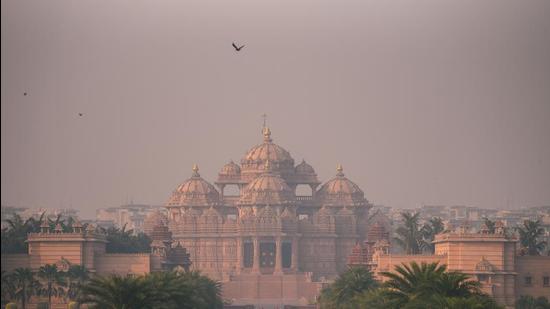Explained: Delhi’s air pollution spikes year-round
Data has shown that the national capital witnesses spike in air pollution in three periods of the year for which a number of meteorological factors are responsible, besides the local sources of pollution. An explainer
Factors in play (to be plotted in a graphic)

January and February: Extremely low temperatures and low mixing height, with moderate to dense fog in the morning. Low temperature and moisture in the air traps pollutants close to the surface. Both months witness ‘severe’ air days.
March and April: Wind direction changes from north-westerly to south-westerly, and temperature begins to rise. The mixing height increases, allowing pollutants to disperse freely.
May and June: Temperatures peak during this period, which is good for dispersal of pollutants. But, a combination of local winds and south-westerly transport-level winds bring large quantities of dust from Rajasthan.
July, August and September: South-easterly and easterly winds start blowing from the Bay of Bengal as precursor to monsoon winds, and bring moisture and rain to Delhi. Rain settles pollutants, as pollution levels stay at their lowest.
October, November and December: Monsoon withdraws, and wind direction changes to north-westerly that bring emissions from stubble fires in Punjab and Haryana. This coincides with a drop in temperature. December generally sees the first ‘very dense’ fog spell of the year, with temperatures dipping below 5 degrees Celsius. This makes it difficult for pollutants to disperse.
What conditions generally lead to smog in late October and early November?
The south-west monsoon withdraws by the first week of October. This triggers a change in wind direction and north-westerly winds start blowing from Punjab and Haryana through the Indo-Gangetic Plains, all the way up to West Bengal. These winds are colder and dryer as compared to the south-easterly winds blowing earlier, leading to a drop in temperature by the end of October. The winds also bring pollutants from stubble burning towards Delhi. Farm fires start to pick up pace October 15 onwards. Firecracker burning on Diwali, celebrated during late October or early November, combined with stubble emissions lead to a smog.
Why it spikes in the end of December?
Stubble burning has completely stopped by this time of the year. Pollution spikes largely becauses temperatures dip to 1-3 degrees Celsius. Colder air slows down dispersal of pollutants and brings down the mixing height, trapping pollutants close to the ground. Delhi also sees fog spells at this time, as the moisture also traps pollutants in the air.
What is behind the third pollution spike?
In summers, dust is the most prominent pollutant, characterised by high PM 10 concentration in the air. A third spike is generally observed towards the end of May and early June, when south-westerly winds from Rajasthan bring coarser particles towards Delhi, while farm fires in the neighbouring Haryana and Punjab during the Rabi harvest season, towards the end of May also brings a stubble emissions. Finer pollutants disperse easily due to high temperatures but dust can still stay in the air. Instances of trans-boundary dust pollution, coming all the way from the West Asia have also been reported across NCR in the past, leading to ‘very poor’ to ‘severe’ air in the summer.
What is the role of temperature?
Low temperatures not only make the air heavier and slows down pollutants, but it also brings down the mixing height -- an invisible layer of the atmosphere within which pollutants mix. The closer this layer drops to the surface, the lesser the space for pollutants to mix freely.
How does fog causes spike in pollution?
Moisture in the air traps pollutants and makes them heavier, not allowing them to disperse easily. This can lead to a constant haze in the air that dissipates only when there is adequate sunlight leading to warmer air.
How far can stubble emissions travel?
Satellite data shows stubble emissions can travel all the way across the Indo-Gangetic plains. However, they start dispersing after a few hundred kilometres, and generally lose their potency after crossing Delhi-NCR. The longer the distance they travel, the lesser their impact.
Stay updated with all top Cities including, Bengaluru, Delhi, Mumbai and more across India. Stay informed on the latest happenings in World News along with Delhi Election 2025 and Delhi Election Result 2025 Live, New Delhi Election Result Live, Kalkaji Election Result Live at Hindustan Times.
Stay updated with all top Cities including, Bengaluru, Delhi, Mumbai and more across India. Stay informed on the latest happenings in World News along with Delhi Election 2025 and Delhi Election Result 2025 Live, New Delhi Election Result Live, Kalkaji Election Result Live at Hindustan Times.





